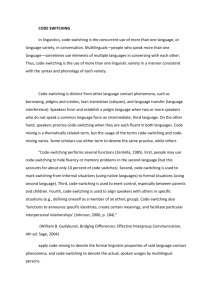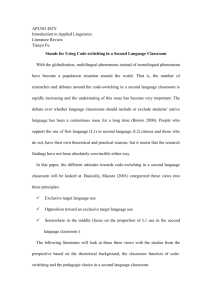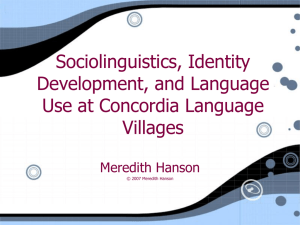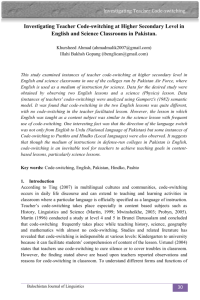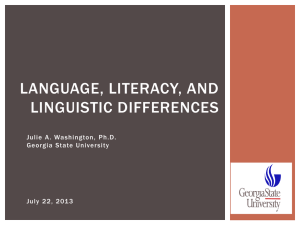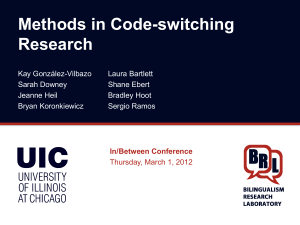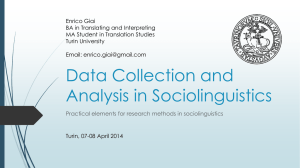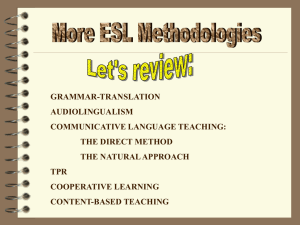Introduction - University of Oxford Department of Education
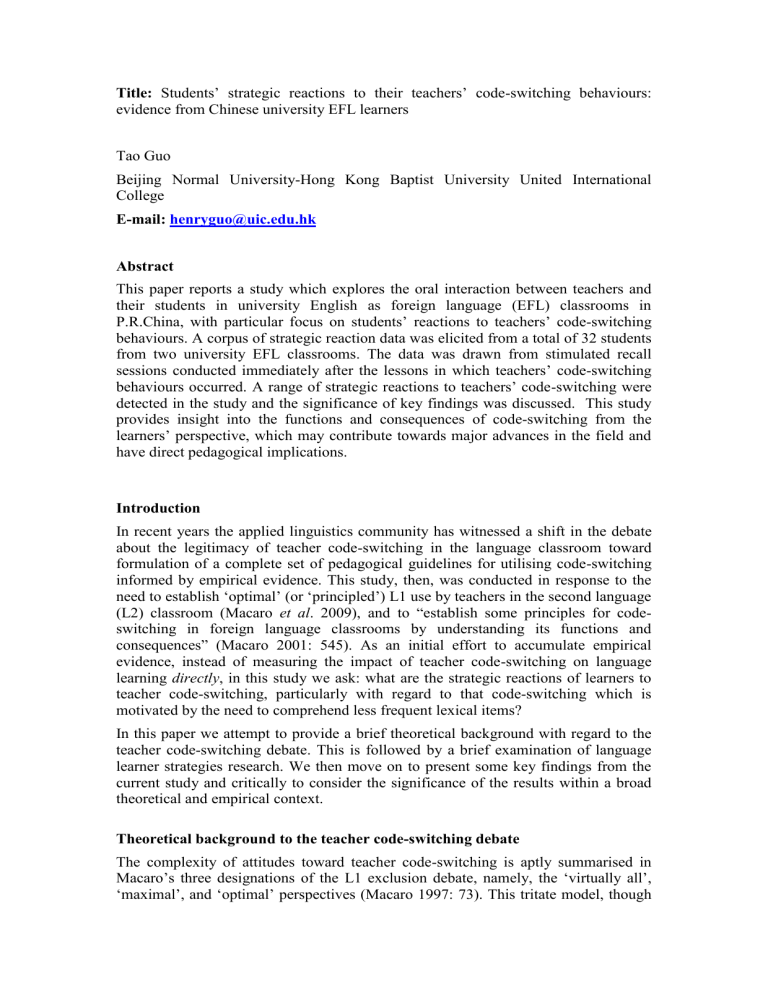
Title: Students’ strategic reactions to their teachers’ code-switching behaviours: evidence from Chinese university EFL learners
Tao Guo
Beijing Normal University-Hong Kong Baptist University United International
College
E-mail: henryguo@uic.edu.hk
Abstract
This paper reports a study which explores the oral interaction between teachers and their students in university English as foreign language (EFL) classrooms in
P.R.China, with particular focus on students’ reactions to teachers’ code-switching behaviours. A corpus of strategic reaction data was elicited from a total of 32 students from two university EFL classrooms. The data was drawn from stimulated recall sessions conducted immediately after the lessons in which teachers’ code-switching behaviours occurred. A range of strategic reactions to teachers’ code-switching were detected in the study and the significance of key findings was discussed. This study provides insight into the functions and consequences of code-switching from the learners’ perspective, which may contribute towards major advances in the field and have direct pedagogical implications.
Introduction
In recent years the applied linguistics community has witnessed a shift in the debate about the legitimacy of teacher code-switching in the language classroom toward formulation of a complete set of pedagogical guidelines for utilising code-switching informed by empirical evidence. This study, then, was conducted in response to the need to establish ‘optimal’ (or ‘principled’) L1 use by teachers in the second language
(L2) classroom (Macaro et al . 2009), and to “establish some principles for codeswitching in foreign language classrooms by understanding its functions and consequences” (Macaro 2001: 545). As an initial effort to accumulate empirical evidence, instead of measuring the impact of teacher code-switching on language learning directly , in this study we ask: what are the strategic reactions of learners to teacher code-switching, particularly with regard to that code-switching which is motivated by the need to comprehend less frequent lexical items?
In this paper we attempt to provide a brief theoretical background with regard to the teacher code-switching debate. This is followed by a brief examination of language learner strategies research. We then move on to present some key findings from the current study and critically to consider the significance of the results within a broad theoretical and empirical context.
Theoretical background to the teacher code-switching debate
The complexity of attitudes toward teacher code-switching is aptly summarised in
Macaro’s three designations of the L1 exclusion debate, namely, the ‘virtually all’,
‘maximal’, and ‘optimal’ perspectives (Macaro 1997: 73). This tritate model, though
far from exhausting all possible arguments, encapsulates some key claims in the debate about teacher language choices and alternations in L2 classrooms. The
‘virtually all’ argument promotes the view that L1 has no value whatsoever and should be avoided at all costs. Similarly, the ‘maximal’ view does not acknowledge the role of L1, although its position in this respect is less extreme than that held by the proponents of the ‘virtually all’ view. The ‘maximalists’ perspective upholds that while the use of L1 should be avoided, in view of the fact that the ideal classroom state does not exist, the use of L2, where necessary, is inevitable. Those proponents of the third perspective, the ‘optimal’ view, consider the use of L1 to have pedagogical value, and as a consequence, believe that its role should be acknowledged. However, there is general agreement among those holding the ‘optimal’ perspective that L1 use should be controlled, and that optimal principles and guidelines should be established and informed by empirical research.
The first two views are related to theoretical beliefs pertaining to whether the acquisition process of L2 resembles that of L1, the affirmation of which may shed light on the justification for teacher code-switching in the L2 classroom. If L2 duplicates the L1 process, the exclusion of L1 would seem to be justified. Another theoretical premise is concerned with the belief that L2 learning should happen solely through L2 rather than being linked to L1. The exclusion of L1 may imply that L2 learning is influenced by compound bilingualism rather than coordinate bilingualism
(Weinreich 1953). The third premise is concerned with the input theory. Krashen’s input hypothesis dictates that the prerequisite for realising the goal of acquisition is to maximise comprehensible input in order to lead to acquisition (Krashen 1978). As a result, anything other than L2 should be kept to a minimum, if not completely eliminated. Being unable to do so may lead to the risk of deprivation of valuable target language (TL) input for learners (Ellis 1984). In other words, these theories seem to provide some support for the exclusion of L1 in the L2 classroom; however, the issue of code-switching in the L2 classroom is far from straightforward. The theoretical rationale for the optimal role of L1 is provided below.
Theories that presuppose the facilitative effect of code-switching (or L1) in L2 learning may include linguistic theory, socio-cultural theory and cognitive theory. In linguistic theory, code-switching has been increasingly acknowledged as a competence of a bilingual both in the naturalistic setting (Poplack 1980, 1988; Tay
1989; Myers-Scotton 1993) and in the bilingual classroom setting (Canagarajah 1995;
Lin 1996). An L1 facilitative effect in the L2 classroom may be supported theoretically by perceiving as the same phenomenon code-switching in the instructional context and code-switching in naturalistic environments. Also in support of an L1 facilitative effect is socio-cultural theory. This theory is grounded on the social-cultural aspect of one’s thinking and behaviours, in particular, the issue of the extent to which the tasks and activities of externalising one’s inner voice and expressing private speech can be carried out in L1 (see, for example, Brooks and
Donato 1994). Cognitive theory postulates the existence of one integrated mental lexicon (Cook 2001; Macaro 2003), which produces conceptual connections and activations that are not language specific until they are required to be so by the processing function needed. In such a model, all closely related representations are assumed to be activated by a given stimulus, regardless of whether they were originally created through one language or another (Kroll 1993; Libben 2000; N. Ellis
2005). These theoretical orientations toward the inclusion of L1 may be appealing.
However, whether they justify the issue of code-switching in the L2 classroom remains debatable without consideration of the empirical evidence relating to the impact of teacher code-switching on L2 learners and their learning.
Language learner strategies (LLS) research
In the past three decades, there has been considerable growth in LLS research (for a recent review, see Cohen and Macaro 2007). Earlier research into LLS was descriptive, being concerned principally with identifying what “good language learners” do to optimise their learning. The intention of such research was to attempt to pass onto less successful learners the strategies found in good learners
(Rubin 1975; Stern 1980; and Naiman et al ., 1978). Researchers later in the 1980s continued their investigations into the techniques employed by learners to aid their learning.
Studying the way in which learners react to their teacher’s code-switching embedded in the input may bear a somewhat close resemblance to an investigation into learners’ strategies for accessing meaning in reading and listening activities. While there is a wealth of theoretical and empirical literature dealing with the latter, there is virtually no published research on learners’ strategies directed at teachers’ code-switching, which forms part of the input in most L2 classrooms around the world. The lack of research into the students’ perspective leaves incomplete the picture of the effect of classroom methodologies on learning, thus rendering it difficult to offer recommendations for methods and practice in second language pedagogy (O’Malley and Chamot 1990). In view of this, the present research approaches teacher codeswitching from a somewhat neglected perspective, and one previously prevalent only in the context of discussions and suggestions in the literature.
Context of the study
To render the research meaningful and valid, a study of teacher code-switching occurring in broadly communicative classrooms was necessary. Examining the L2 by making comparisons with the L1 might be regarded as conflicting somewhat with the basic premise of the CLT teaching approach. However, the approach adopted in the study certainly does not undermine the very principle of CLT in the way grammar translation classrooms do. This study required the two participating non-native speaker teachers to possess near-native proficiency in L2, and to share students’ L1.
Furthermore, it was essential that the direction of the teachers’ code-switching was from L2 to L1, and the matrix of language was L2. If the direction were reversed, the random time out in L1 would invalidate the study. This is because the selection of teacher code-switching episodes for the introspective study would have been difficult due to the possibility of unclear boundary delineation between L2 discourse and L1 discourse. Furthermore, those CS episodes selected might not have been salient enough to trigger any valid cognitive reactions when processing teacher codeswitchings. Thus, sufficient command of students’ L1 was a prerequisite for the principled code-switching behaviour to occur. Thus, the selection of teacher
participants with a relatively balanced proficiency in both L1 and L2 was the most important criterion for the study.
The study
The study was set in 2 university EFL classrooms in Beijing, P.R.China, and involved two cohorts of 32 first-year undergraduate and postgraduate students. In addition, both student groups were non-English major students. This sampling strategy reflects a desire for in-depth understanding of each case in the study. Above all, the sampling allowed a detailed and thorough description of the phenomenon under investigation.
Nevertheless, it should be noted that this was a small case study and there was, inevitably, the possibility of bias in the process of selection. As a consequence, it is not possible to generalise the findings beyond the sample of students in the study.
One of the central research questions concerned in the study was:
What are the online strategic reactions that learners have towards their teachers’ code-switching bursts in oral interaction with them?
Data collection consisted of stimulated recall data followed by the collection of data of Teacher Estimation of their Students’ Lexical Knowledge (TESLK)
Some key findings
A number of themes emerge from the data collected via stimulated recall. Apart from the evidence of learners’ automatic and procedural accommodation of some teacher code-switching, quite a considerable number of respondents described how they drew on their attentional resources and employed cognitive strategies to process those codeswitches predominantly targeting the low-frequent lexical items in their teachers’ speech. It appears that this kind of strategic reaction is often detected in the context of the complex form and meaning relationships in the two languages, as we can see from the examples below. Here, the “strategic reaction to a teacher’s lexis-related codeswitch” might be said to be the mechanism the learner employs in order to acquire the lexical item highlighted by the teacher. Given the space limitation, an overview of the findings is provided here.
Example 323
‘fruitful’
1. Cindy: …Can you tell me the meaning of ‘fruitful’?
2. Student: ‘ 成果 ’ [ tr. ripened fruits; good outcome of an effort ]
3. Cindy: Yeah, 硕 果累累的有成果的 [ tr. abundantly fruitful, fruitful ], ok, with research
4. environment…
Before noting a student’s strategic reaction to the code-switching related to ‘fruitful’, we should first consider its semantic properties in English, where its literal meaning
(producing much fruit) is closely linked to its figurative meaning (producing good or helpful results). Reflecting back on the episode, one student, Chen Qi, commented:
When she was speaking English and translating her English into Chinese…I suddenly felt slightly confused…. I wondered what the word meant….if she had spoken a Chinese word that was not linked in meaning to the preceding
English word, I would not have been confused [……]. When... for example, she said ‘ 今天早上 [ tr. this morning ]’ in a flow of words and I thought about ‘
今天早上 [ tr. this morning ]’.
(Chen Qi)
In this example, far from being accommodating, the code-switch generates quite substantial disruption or perturbation of the otherwise normal processing of the L2 input. What results is, in effect, a substantial episode of focusing on form on the part of the student, although the teacher has not broken off substantially from the communication of her more general message. She acknowledges the student’s contribution in line 2, which provides both literal and figurative information in L1, but the teacher offers additional L1 information by providing two adjectives: 硕 果累
累的 and 有成果的 to match the English adjective ‘fruitful’. The Chinese character “
的 ” is an inflection for constructing adjectives. In addition, she confirms semantic equivalence for ‘fruitful’ in both languages, that is, evidence of a cross-over in formmeaning connections in both languages between two related ideas and their lexical/morphological manifestations. Whether this leads to better opportunities for recall we do not know, but there is a suggestion that the student’s strategic reaction is more intense and may have afforded deeper processing opportunities than an L2 definition alone. This is an interesting example which probably merits further discussion than space allows. Now let us consider another reaction which reports the use of vocabulary learning strategies.
Example 407 (med L2-L1; target item ‘values’; TESLK = item ‘known’)
.…You may find that your values, your prejudices are challenged, values here means in Chinese 价 值观 , 不是 价 值 , [tr: values(one's judgment of what is important in life), not value (the quantitative worth of material objects) ]. Sometimes, we say, what’s the value of this product…?
In this extract, the teacher does not attempt a comprehension check, but rather preempts possible hypothesis generation and provides a Chinese equivalent (twice) of the word ‘value’ followed by an immediate contextualization. This code-switch seems also to involve a certain degree of teacher’s conscious effort to help with students’ vocabulary, as suggested by the TESLK data. In other words, given that the English word ‘value’ has other meanings (the quantitative worth of material objects), there is an attempt by the teacher to demonstrate that it also has a figurative meaning. This dual meaning is represented by the two different L1 equivalents in Chinese. One student’s strategic reaction is as follows:
When she spoke (in English), I was thinking of the meaning of ‘value’, then the teacher said “ 价 值观( tr: one's judgment of what is important in life ) ”, then, I placed the meaning into the sentence and had a go at it (quietly to myself).
(Gu Xin)
It is unclear which meaning of ‘value’ Gu Xin was thinking of before the codeswitch; perhaps the more common value of material objects. The interesting result of the switch is that she then attempts to process the word for recall by placing it in a contextualizing sentence, an important vocabulary strategy in the literature. Whether this is a sentence of her own or the sentence provided by the teacher (i.e. ‘Your values are challenged’), is not clear. What is clear, however, is that the reaction to a teacher code-switch is not a passive one; some very important cognitive processing and strategic decision-making occurs. We turn now to consider a cluster of reactions provoked by code-switches of a similar nature.
Example 411 (med L2-L1; target item ‘adolescence’; TESLK= item ‘not known’)
1. …For instance, adolescence is the transition between adulthood and childhood,
2. childhood and adulthood….Do you know what adolescence means?
3. adolescence?...
青 少 年 , 青 春 期 , [tr: teenager, adolescence]…adolescence, adolescence,
4. adolescence …
When she mentioned ‘adolescence’….it was new to me….at the beginning I felt confused and guessed it was ‘puberty’ when I heard childhood and adulthood….my guess was confirmed by her Chinese.
(Feng Tao)
Example 715
‘ordeal’
1 … So, the first paragraph said, ok, (inaudible) whether for a college or for
2 a job, most people face this ordeal (referring to an interview). Ordeal
3 means a hard task, or a big problem, ok? Ordeal, 严 峻的考 验 或者是何 种
4 麻 烦 [ tr: a serious challenge or problem ], (she resumes reading aloud the
5 text) However, people who prepare for interview…
One student’s reaction is:
I could understand her English explanation.. [but]…I felt more sure about it when I heard her Chinese explanation.
(Li Meizhu)
Example 1360 (med L2-L1; target item ‘pollutant’; TESLK= item ‘probably known’)
…Even each individual is a pollutant, pollutant, 污染体 [tr: pollutant], (writes it on the board). Yes, pollutant…
My first reaction was, prompted by the code-switch, I would first think about the meaning in Chinese, then the meaning in English. For example, (talking to myself) pollutant, pollutant. First, I would think about all kinds of pollutants in
Chinese, then I realised that, oh, the Chinese 污染体 [tr: pollutant] is the word
‘pollutant’ (in English).
(Kang Wenhao)
Example 1566 (med L2-L1; target item ‘trauma’; TESLK=item ‘not known’)
…Because he was hurt. The scar, the trauma 创伤 [ tr. trauma ], was left by the person whom he loved so much. So that is why sometimes love and hatred are just one step aside….
I understood ‘scar’ immediately, but the other I didn’t understand at all. I was wondering what it meant, when John said ‘the trauma’, then 创伤 [ tr. trauma
]… but I still couldn’t figure out its spelling (laugh). Then I decided to check it after class.
(Chen Lei)
In all these examples there is ostensibly a positive cognitive reaction to the codeswitches. Firstly, the L1 information provides reassurance about the meaning of low frequency words such as ‘adolescence’, ‘ordeal’, ‘pollutant’ and ‘trauma’. Secondly, it seems to trigger deeper processing of semantic links in working memory. Third, the reaction to these code-switches has begun to provide evidence that provision of L1 and L2 connection in the code-switches has not only made possible the semantic aspect of acquisition of target lexical item, but also begun to provide a deeper and optimal processing opportunity for the uptake of the target lexical items. However, this claim requires substantiation from empirical evidence. Notwithstanding, we do currently have abundant evidence to show that:
1) Code-switching provides evidence to confirm students’ hypothesis testing;
2) Code-switching provides opportunities for deep processing through contextualisation;
3) Code-switching provides information used in additional processing.
The significance of the above finding is discussed in the next section.
Discussion and conclusion
As consistent with most studies which explore the functions of teacher code-switching
(e.g. Kaneko 1991; Cook 2001; Macaro 2001), much teacher code-switching appear to centre upon unfamiliar or unknown L2 lexical items. However, this known fact alone cannot provide evidence to warrant any claim related to the optimality of the
functions of teacher code-switching, without actually gauging the impact of teacher code-switching by asking students directly. Thus, this study sought to understand the impact of teacher code-switching by asking student participants to verbalise their online strategic reactions to the L2 input with embedded L1 code-switching presented to them immediately after the lesson. This initiative was primarily motivated by the tentative suggestions of a number of researchers (e.g. Kern 1994; Spada and
Lightbown 1999; Hawras 1996) as to the role of L1 as a strategy contributing to language processing, which have been enthusiastically postulated, but not empirically supported.
What may be extrapolated from the evidence in the current study is that codeswitching can be employed as a strategy to help lighten the cognitive load (Macaro
2005). A code-switch, according to Macaro (2005), “can reduce the selective attention dedicated to a single communication breakdown, freeing up working memory capacity to work on the meaning of larger chunks of input whilst at the same time offering the hearer the opportunity of quick storage of an L1-L2 equivalent they were previously not aware of” (Macaro 2005: 74-75) .
The above hypothesis is supported in the present study in so far as initial empirical evidence suggests similar use of codeswitching to lessen learners’ processing burden. In other words, when learners make the effort to process those short bursts of medium-oriented code-switching targeting low-frequency lexical items, the selective attention they apply can be considerably reduced with the help of teachers’ strategic use of L1 equivalents for those lexical items. Without code-switching, a considerable amount of selective attention will be expended in guessing and inferencing from the context, which is sometimes a source of anxiety and negativity towards TL use reported from the data in this study and elsewhere (e.g. Levine 2003). Furthermore, without the use of code-switching, the working memory capacity would be limited to the processing of smaller chunks of input. At the same time, without code-switching, it might not be possible to connect the new information with existing learnt information in the learner’s mental lexicon, and the simultaneous, quick storage of L1 and L2 equivalents would probably become less likely. Another possible drawback of the absence of code-switching is that when encountering less frequent lexical items, students are likely continually to refer to their dictionaries in the class, and thus run the risk of losing track of the teacher’s input. As apparent from the lesson video, to remedy this, teachers sometimes have to slow down or resort to input modifications, which, on occasion, may prove timeconsuming. Thus, the use of code-switching may keep students engaged in mental activities that otherwise would be difficult in an exclusively L2 environment. Above all, as selective attention must be strategically allocated to cater for competing demand from various activities (Schmidt 2001), teacher code-switching may help learners reduce the cognitive load without the cost of losing general attentional focus on understanding the teacher’s input. To tackle the limits of working memory processing capacity, “it is not an unwise conjecture that the noticing will be mediated by the L1” (Macaro 2001: 126).
However, this is not to claim that all kinds of code-switches can be of equal assistance in reducing selective attention and optimising the processing. We may justifiably assume that some may be less facilitative, even of hindrance to the learning process.
We have reason to question that this issue of increasing/decreasing processing load may be confounded by the nature of the following refined kinds of teacher codeswitching such as the exact or near exact L1 and L2 equivalent, the circumlocution of
L2 lexical items in L1, and the translation of L2 definition of the lexical item in L1,
L2 synonyms and L2 definition. This merits further research effort.
In summary, we can confidently state that, first, this study provides evidence that teacher code-switching in the classroom is at least not detrimental to the learning process. The unjustified frowning upon teacher code-switching is not reasonable at all. Second, it might be possible, when empirical evidence accrues, to build a more comprehensive and coherent set of guidelines for informing teaching practice.
Teacher code-switching may need to be more attuned to the needs of the particular learners in a classroom at any one time, to allow the development of language learning to occur simultaneously for learners of different abilities. Thus, the current study offers opportunities to re-examine the debate on teacher code-switching, and hopefully, to provide empirical evidence to advise on its optimal use.
References
Brooks, F.B. & Donato, R. (1994). Vygotskyan approaches to understanding foreign language learner discourse during communicative vases. Hispania , 77 , 262-274.
Canagarajah, A. S. (1995). Functions of code-switching in ESL classrooms: socializing bilingualism in Jaffna. Journal of Multilingual and Multicultural
Development , 6, 173-195.
Cohen, A. and Macaro, E. (2007). Language Learner Strategies: 30 Years of
Research and Practice.
Oxford: Oxford University Press.
Cook, V. J. (2001). Using the first language in the classroom. Canadian Modern
Language Review, 57(3), 402-423.
Ellis, N. (2005). At the interface: Dynamic interactions of explicit and implicit language knowledge. Studies in Second Language Acquisition, 27, 305-352.
Ellis, R. (1984). Classroom Second Language Development . Oxford: Pergamon.
Hawras, S. (1996). Towards describing Bilingual and Multilingual Behaviour:
Implications for ESL Instruction , Double Plan B Paper, Department of English as a
Second Language. University of Minesota, Minneapolis.
Hird, B. (1996). The incompatible objectives of groupwork in FL learning: a study of
Chinese-English code-switching. Language, Culture and Curriculum , 9, 163-175.
Kaneko, T. (1992). The role of the first language in foreign language classrooms.
Unpublished Doctoral dissertation, Temple University, USA.
Kern, R. G. (1994). The role of mental translation in second language reading. Studies in Second Language Acquisition 16, 441-61.
Kroll, J. (1993). Assessing conceptual representations. In R. Schreuder and B.
Weltens (Eds.), The Bilingual Lexicon . Amsterdam/Philadelphia: John Benjamins.
Krashen, S. D. (1987). Principles and Practice in Second Language
Acquisition . Prentice-Hall International.
Lantolf, J. P. (2006). Socio-cultural theory and L2: State of the art. Studies in Second
Language Acquisition , 28, 67-109.
Levine, S. G. (2003). Student and instructor beliefs and attitudes about target language use, first language use, and anxiety: Report of a questionnaire study, The
Modern Language Journal, 87(3): 343–364.
Libben, G. (2000). Representation and processing in the second language lexicon: the homogeneity hypothesis. In J. Archibald (Ed.), Second Language Acquisition and
Linguistic Theory (pp. 228-248). Oxford: Blackwell.
Macaro, E. (1997). Target Language, Collaborative Learning and Autonomy .
Clevedon: Multilingual Matters.
Macaro, E. (2001). Analysing student teachers’ code-switching in foreign language classrooms: Theories and decision making. Modern Languages Journal , 85, 531-548.
Macaro, E. (2003). Teaching and Learning a Second Language: a Guide to Current
Research and its Applications.
London: Continuum.
Macaro, E. (2005). Code-switching in the L2 classroom: A communication and learning strategy. In E. Llurda (Ed.) Non-Native Language Teachers: Perceptions,
Challenges, and Contributions to the Profession (pp. 63-84). Boston, MA: Springer.
Macaro, Guo, Ella and Lili (2009). Can differential processing of L2 vocabulary inform the debate on teacher code-switching behaviour: the case of Chinese learners of English? in Meara, P.(ed) Vocabulary Studies in First and Second Language
Acquisition: the Interface between Theory and Application. Basingstoke: Palgrave
Macmillan .
Naiman, N., Frohlich, M., Stern, D. & Todesco, A. (1978). The Good Language
Learner.
Canada: Ontario Institute for Studies in Education.
Myers-Scotton, C. (1993). Social Motivations for Code-switching : Evidence from Africa . Oxford : Clarendon Press.
O'Malley, J. M., and Chamot, A.U. (1990). Learning Strategies in Second Language
Acquisition. Cambridge: Cambridge University Press.
Poplack, S. (1980). "Sometimes I'll start a sentence in Spanish y termino en español": toward a typology of code-switching. Linguistics 18: 7/8: 581-618 .
Poplack, S. & Sankoff, D. (1988). Code-switching. In Ammon, U., Dittmar, N. and
Mattheier, K.J. (eds), Sociolinguistics. An International Handbook of the Science of
Language and Society . Vol. 2. Berlin: Walter de Gruyter. 1174-1180.
Schmidt, R. (2001). Attention. In Robinson, P. (Ed.), Cognition and Second Language
Instruction (pp.3–32). Cambridge: Cambridge University Press.
Spada, N. and Lightbown, P. M.(1999). Instruction, first language influence and developmental readiness in second language acquisition. The Modern Language
Journal , 83,1,1-22.
Tay, M.W. (1989). Code-switching and code-mixing as a communicative strategy in multilingual discourse. World Englishes, 8, 407-417.
Vandergrift, L. (2003). Orchestrating strategy use: Towards a model of the skilled L2 listener. Language Learning, 53, 461-494.
Weinreich, U. (1953/1968). Languages in
Contact: Findings and Problems.
New York: Linguistic Circle of New York.
